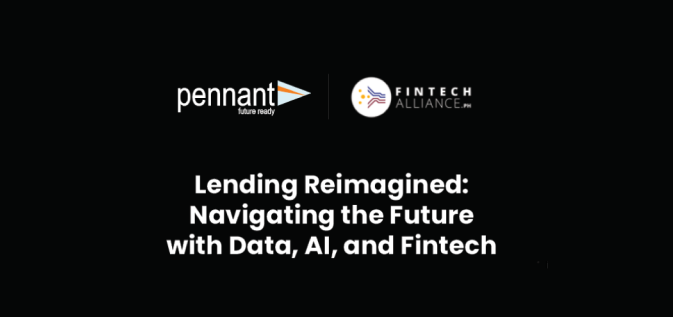
The recent event, “Lending Reimagined: Navigating the Future with Data, AI, and Fintech,” co-hosted by Fintech Alliance and Pennant, brought together industry leaders to discuss the future of digital lending in the Philippines. This landmark event underscored the pivotal role of technology in transforming the financial landscape, with insights from thought leaders, engaging panel sessions, and in-depth discussions on emerging trends and challenges in digital lending.
The Rise of Platform-Based Strategies in Fintech
Lito Villanueva, Chairman of Fintech Alliance, set the tone with a powerful keynote on how platform-based strategies are revolutionizing the fintech sector. Emphasising the shift from disruption to leadership, Villanueva remarked, “Embedded lending is the new black. But it is not simply a trend; it is a need that Filipinos rely on to make their hopes into realities. It is now our time to turn our attention to lending and reframe it as an important stepping stone towards success.” His statement highlighted the integration of fintech into the very fabric of Philippine society, breaking barriers and driving financial inclusion.
Growth in Digital Lending: A Key Takeaway from the Event
According to recent data from the Bangko Sentral ng Pilipinas (BSP), the loan book for digital banks is expected to double this year, reflecting the growing appetite for digital lending solutions in the market. From April 2023 to April 2024, outstanding loans of living banks, excluding lending to banks, grew by 9.6% per year, equivalent to approximately 11.3 billion pesos. This growth underscores the increasing reliance on digital platforms to meet the evolving needs of borrowers in the Philippines.
Evolving Perceptions of Lending Among Filipinos
The event also highlighted a significant shift in the attitudes of Filipinos towards lending, driven by the increasing accessibility and convenience of digital platforms. Historically, lending was viewed with caution due to lengthy processes and rigid requirements. However, the rise of digital lending has transformed this perception, making borrowing more accessible and aligning with the fast-paced lifestyle of today’s consumers. Filipinos are now more open to exploring various lending options, experiencing first-hand the speed and efficiency of digital solutions. This shift is seen as a pivotal change in the market, with panellists emphasising that the new digital era of lending is not just about providing loans but also about empowering consumers with seamless access to credit that meets their immediate needs. As embedded lending becomes more integrated into everyday transactions, it is reshaping how financial services are viewed and utilised across the Philippines.
The Power of Data in Lending Decisions
BPI’s VP & Head of Retail Lending, Dexter Lloyd Cuajotor, emphasised the importance of speed and data accessibility in today’s lending landscape, stating, “What is valued right now in terms of lending is speed.” Supporting this perspective, Atty.Ben Altzaar, President, The Credit Information Corporation (CIC) stated that “CIC does it better and highlighted that contributing to data is important, and access to data is equally crucial. It marks better data-driven decisions for your loan operations.” He also mentioned about the increase in the use of credit reports, noting that 3.1 million credit reports were generated by online lenders in 2024.
Traditional vs Digital Lending: A Comparative Insight
A significant theme across the sessions was the comparison between traditional lending methods and digital lending powered by AI. Digital lending not only enhances the speed and accuracy of loan processing but also allows for more personalised borrower experiences. The transition from traditional to digital lending models is seen as a key driver of innovation in the industry, with AI enabling more precise risk assessments and customer insights.
The Future of AI in Lending
AI’s role in lending was a focal point, particularly in improving data quality and decision-making processes. The discussion highlighted how AI can be explored at various stages, from loan submission to servicing, enhancing banks’ capabilities to provide rich and accurate data. While the cost of AI implementation can be high, the panel suggested partnering with specialised fintech firms to leverage their expertise and reduce costs.
Modernising Core Systems
The session explored the challenges associated with modernising core systems, identifying budget constraints, a shortage of specialised skill sets, and integration complexities as primary hurdles. Addressing these challenges is essential for financial institutions aiming to enhance their agility and scalability in a rapidly evolving market.

Rama Raju, Director & CEO, Pennant Technologies discussed the concept of “hollowing out the core,” advocating for a phased approach to digital transformation. He noted, “Digital transformation should happen over years in phases rather than in one shot, focusing on taking out key components. Digital servicing end-to-end is also crucial, not just onboarding.”
Further discussions delved into the transformative impact of data and AI on lending practices. Speakers highlighted how advanced analytics can turn raw data into actionable insights, allowing lenders to make more informed decisions, mitigate risks, and drive operational efficiency. The emphasis was on the importance of data-driven strategies in optimising loan operations, with industry leaders sharing successful implementations that have fostered innovation and enhanced customer experiences in the lending sector.

The event underscored the transformative potential of data, AI, and fintech in reimagining lending in the Philippines, offering a glimpse into the future of financial services. As the country continues to embrace digital transformation, the insights shared at this event will undoubtedly shape the strategies of lenders and fintech companies alike.
Conclusion
The “Lending Reimagined” event not only highlighted the rapid advancements in the fintech sector but also stressed the need for ongoing innovation and adaptation. With the digital lending landscape in the Philippines poised for significant growth, the focus now shifts to how financial institutions can leverage data and AI to better serve their customers and drive the next wave of financial inclusion.
Recent Blogs
In the spotlight